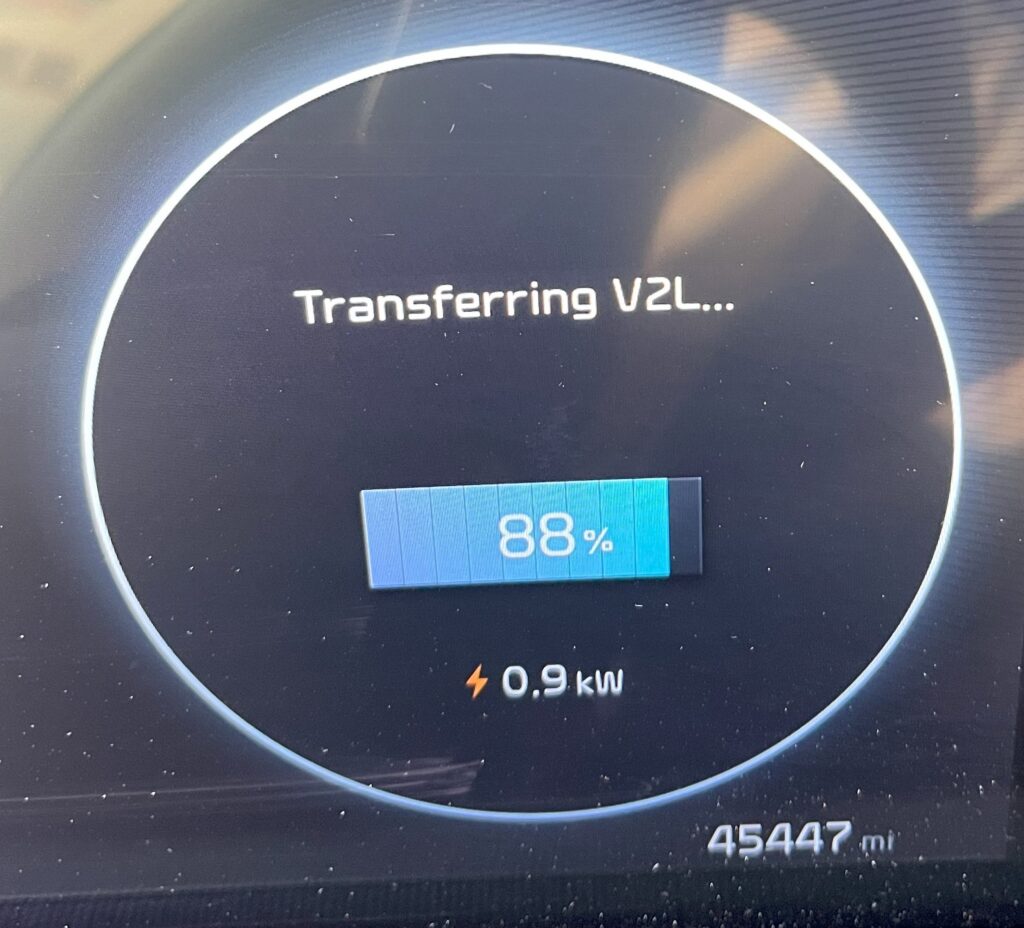By Alan Shedd
We used the energy stored in our Kia EV6 and its Vehicle to Load (V2L) capability to power a small window air conditioner for 68 hours in the power outage caused by Hurricane Helene. It kept the house comfortable, and was less expensive, quieter and less polluting than our Honda generator.

We had plenty of energy left in the car to run errands if needed and recharged the car once power was restored. Electric vehicle V2L capability is a useful tool and provides a much-welcomed energy source during an extended power outage.
My wife and I have a home in coastal Georgia on the Sapelo River. Like many in the area, our power was knocked out in the predawn hours of Friday, Sep. 27, as Hurricane Helene barreled through.
The area is remote, and there are lots of trees and aging infrastructure. Outages are common. Most are short duration but Hurricane Matthew, Hurricane Irma and even a freak winter snowstorm caused multi-day outages that prompted us to install a modest solar power system with battery backup that can keep the refrigerator, lights, computer, well pump and other critical loads running.
When grid power failed, the batteries took over until the sun came out after the storm. Unfortunately, the small system can’t handle big loads like central air conditioning and water heating. (System upgrades are in my future). The 90-degree heat and humidity of coastal Georgia with days of yard clean up would have been more than unpleasant.

The solution was parked in the driveway My 2022 Kia EV6 is equipped with a V2L adapter that can provide 120-volt AC power to tools and appliances using the energy stored in its large 77 kWh battery. I have used the V2L feature to power fans and a coffee maker at events and to run power tools at a construction site. Using it to provide backup power to my home would be a new challenge.
I had purchased a small, very efficient, quiet window air conditioner last summer with the thought of running it on solar or using a small Honda generator. I mounted the window unit, ran an extension cord from the car to the house and powered it up.
It ran continuously for nearly three days using about 438 watts of power. Even though it was undersized to adequately cool the entire house, it made a big difference keeping the humidity below 50% and the temperature in the 70’s.
When first connected, the car’s battery was at 88% state of charge. When power was restored 68 hours later and I turned off the AC, the car battery was at 42%. In addition to powering the air conditioner, I used the car to recharge a portable power station twice using an additional 2 kWh of the car’s stored juice.
The math:
- Car battery stores 77 kWh of electricity.
- During the outage the car battery was discharged from 88% to 42% or 35.4 kWh
- We had over 100 miles in range left.
- The air conditioner ran continuously for 68 hours consuming 29.8 kWh
- Charging the power station consumed an additional 2 kWh
- There is some energy loss in the car’s DC to AC conversion
- Recharging the vehicle battery consumed $4.60 in electricity

- Before connecting to the EV6 V2L output, I used my Honda generator to power the air conditioner. It burned 1 gallon of gas in nine hours of operation. So had I used the generator instead of the car, I would have burned 7.6 gallons of ethanol-free gas, at a cost of $30.40 plus the noise and pollution.
- Our solar system consists of 2 kW solar panels, 10 kWh LFP batteries and 9 kW grid interactive inverter with standalone capability.
- Air conditioner: Energy Star listed Midea 8,000 Btu/h window unit with U-shape design for reduced indoor noise.
We were pleased with the outcome – not only the comfort it provided, but the cost savings, reduced noise and pollution, and flexible long-duration power supply. It provides another example of how electric vehicles make one’s life better.
Alan Shedd recently retired as director of emerging technologies at Oglethorpe Power Corporation and is now an energy consultant with Integrated Energy Systems. Banner image: The Kia EV6’s Vehicle to Load (V2L) system being used. (Photo courtesy of Alan Shedd).
If you are interested in submitting an opinion piece to The Invading Sea, email Editor Nathan Crabbe at ncrabbe@fau.edu. Sign up for The Invading Sea newsletter by visiting here.




As the next hurricane is blowing in and about to land in Florida, this article makes me want to get an EV. With all the electric school buses in Florida, we need the utility companies to look at vehicle to grid (V2G). An electric school bus is a giant electric generator that is mobile and can be used for cooling stations, cell phone charging sites and back up power.